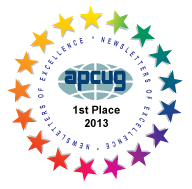July 5, 2013
The meeting was called to order at 7:37 p.m. by President Chuck Horner. See Lola Hunter at the ticket table for raffle tickets, door prize tickets, and 3" x 5" cards to write questions for discussion/answers at the end of the Meeting. Get at least one $5 raffle ticket for this month's raffle prize, a 32GB microSD card.
Michael Wong renewed his membership and brought several friends, Jennifer, Dana, and Alex. Paul Rogers, Sally Holt, and David Graham also renewed. Chuck acknowledged Sally for the wonderful raffle prizes she has obtained.
Chuck will follow up with Sid Jordan about Heald College's offer to donate 30 computers.
SIG Announcements:
The Spectacular Linux SIG meets the last Saturday of the month in Hayward. They will be looking at the technical aspects of PEAR Linux, a clone of iOS 10.6.
We need someone to help with programs and someone to help with publicity. If you can help in any way, let a member of the Executive Committee know.
Anyone present who did not receive a newsletter? Two people did not. Diane suggested that they check their Junk Mail or Spam folders.
Presentation:
Jan Fagerholm started off by distinguishing between tablets and desktop/laptop computers. Windows does not lend itself to the tablet interface. Steve Jobs developed the graphical interface and then scored another innovation iOS designed for the multi-point capacitive touch screen. One of the advantages that Apple has had historically because they develop both the hardware and software and integrate them well.
Google has been looking to expand into their touch screen. Google is a software company based on Linux. They focused on the software for touchscreens and license to various hardware manufacturers. Right now, Samsung is one of the best implementers.
Inexpensive tablets are usually 4-point rather than 10-point touch, less memory, and are relatively slow. The tablet maker is responsible for software updates; the buyer is dependent on the manufacturer staying in business and providing current updates.
The Kindle reader can be considered a tablet. The older ones have reflective screens, requiring an external light source. The screen display uses about 50% of the power, so turning it off during activities like Navigation saves battery.
The Google partnerships with Motorola was not terribly successful, mostly because of Motorola's failure to market well. The partnership with Samsung is more successful because of marketing. Jan likes the form factor of the Asus Google Nexus 7. That is a personal choice. He also likes that it has satellite GPS so that he can get maps anywhere, whether or not there is phone or WiFi coverage.
There is a learning curve with tablets. Input is touch/gesture based. Apple made a significant dent in the piracy by making music and many apps so inexpensive that piracy is not worth the trouble. Because it is based on open-source Linux, Android has many more free apps, many of them quite good.
The Nexus has a 16:9 ration, which matches movie and current TV displays. The iPad Mini has a 4:3 ratio, which gives a bit more screen real estate. The Nexus has a quick-launch button on the home screen that makes it easy to access the most-used features.
On the Nexus, all the buttons are soft. So when you rotate the device, the buttons all stay in the same relationship. And it has a Back button. Siri (on Apple) requires an internet connection for voice input. Google Voice works locally. The form factor for both allows for two-thumb typing and the keyboard is big enough to accommodate large thumbs.
The Android can multi-task. This is particularly convenient for keeping up with navigation. Files and notifications can be closed by swiping the title to the right.
Diane George showed her Nook HD+ with 32 GB of storage. She thought of it as a ebook reader, but was happy to discover that it is also a tablet. With a connector, she can output to the projector or to a TV. It can take up to 32 GB SD card. She took the card from her old Nook, and the new device recognized all her stored material. It also has a Settings button on top. She found out that it will connect with a Bluetooth headset only if the headset does not have a microphone, since there is a built-in mike. Because content is all stored on the cloud, when she had to reformat the Nook, all but one of her apps was available without a hitch or any need for her to do anything.
The Nook does not have a camera, which Diane does not miss. She does like the USB charger; the USB cable can be connected to her computer and files can be moved by dragging.
Chuck Horner pointed out that the Android has a graffiti app. It works a lot like the Palm interface, for people who are used to that.
After the convivial break, Don Trimble's questions were considered. He has a problem burning a DVD using RealPlayer. Nero and Ashampoo. A search on CNET's Downloads.com for free burners was suggested.
Question #2: How can he reduce the files size of a picture?
Andrew Tews suggested downloading Picture Reducer from Microsoft. There are a lot of free programs to look for.
Sally Holt asked about reducing the size of videos. Separate video editing software is necessary.
Question #3: How can we keep our information from being traced? Any WiFi or GPS will expose you. Be careful about how you use Facebook and other social media. Be aware that cameras that add geodata are also reporting your location.
Thank you to George Kornbluth for taking care of refreshments.
The meeting was adjourned at 9:58 p.m.
Respectfully submitted,
Bayle Emlein, Secretary




